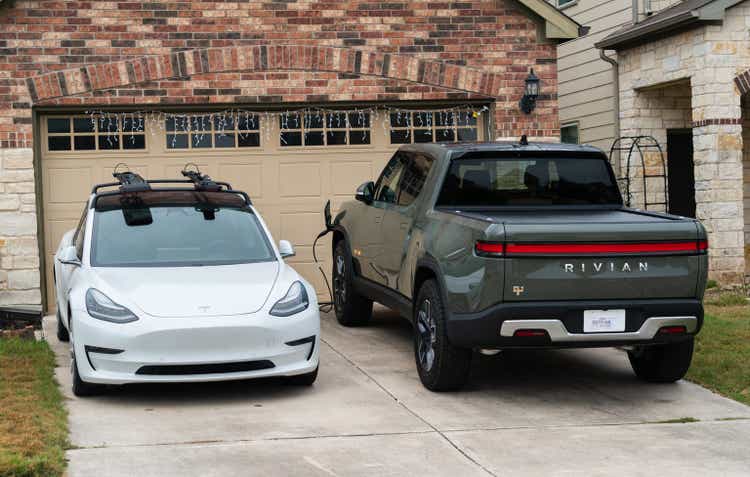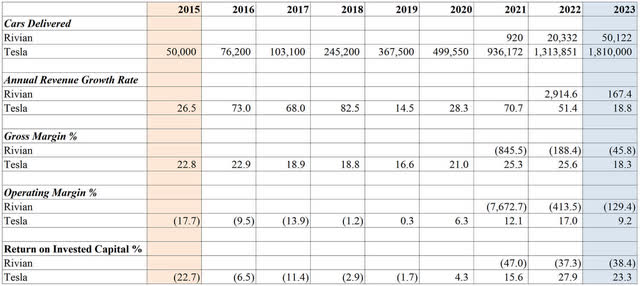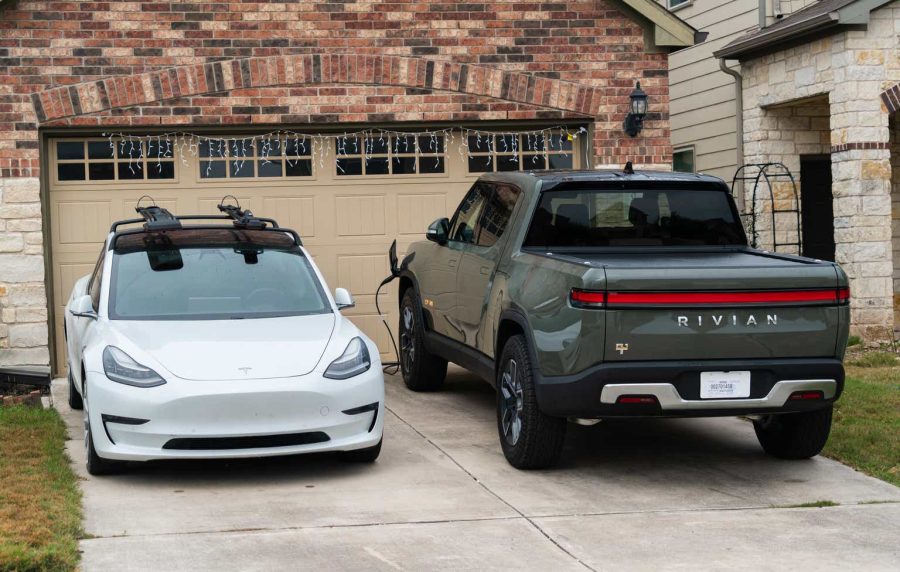Summary:
- Rivian Automotive, Inc. may run out of cash in 2-3 years, lacks scale and produces vehicles at negative gross margin.
- Tesla, Inc. has large economies of scale, is in the process of vertically integrating (battery production, lithium refining) and has ample amount of cash.
- Given the possible slowdown in the EV demand in the U.S., persistently unprofitable Rivian may underperform Tesla with Tesla gearing up to sell $25K models.
- A pair trading strategy of going long on Tesla and short on Rivian presents an attractive risk-adjusted opportunity.
RoschetzkyIstockPhoto
Investment Thesis
My thesis is that Tesla, Inc. (NASDAQ:TSLA) will survive, while Rivian Automotive, Inc. (NASDAQ:RIVN) will decline or get bought out at a much lower price by someone.
Given the current trajectory, Rivian is following in the footsteps of Fisker (FSR), in my opinion. Fisker issued a warning that they may not be able to continue as a going concern due to low car sales. Conversely, Tesla has enough cash to survive the EV demand slowdown and Chinese competition from BYD Company (OTCPK:BYDDF). This makes going long on TSLA and short on RIVN a worthy pair trading strategy.
Is EV Demand Softening in the U.S.?
First, there is a softening in the electric vehicle (“EV”) demand. Most of Rivian’s sales are likely from the U.S. I researched this and Rivian barely has any representations in other countries. According to BloombergNEF, the 2023 growth rate in North America was 45%. It expects the growth rate in 2024 to fall to 31%. It is still positive, but slowing.
There is a lot of debate on what kind of trajectory the EV demand in the U.S. will take in the next several years. Will it go up again by 40%-50% or moderate at 10%-20% going forward? High growth rates were relatively easy to score before given that the EV market started from a very low base. But, it gets harder to generate higher growth rates as EVs reach wider masses. The electric cars must become affordable and convenient to charge first. In my opinion, we are not there yet, but will be in the future. So, moderating growth rates for the EV market for the next several years may make sense as technology and affordability catch up to the expectations of consumers.
Rivian’s Poor Financial Performance
But, the thing is that even with these break-neck growth rates in 2023 and before, Rivian has been in the red.
Table 1. Rivian’s Cash, Debt and Free Cash Flows (in billions of USD)
| 2019 | 2020 | 2021 | 2022 | 2023 | |
| Cash | $2.3 | $3.0 | $18.1 | $11.6 | $9.4 |
| Debt | 0.1 | 0.1 | 1.2 | 1.2 | 4.4 |
| Free Cash Flows | -0.6 | -1.8 | -4.4 | -6.4 | -5.9 |
Source: Morningstar.
We see that its free cash flows were persistently negative. These numbers pretty closely resembles its operating losses. In fact, Rivian is massively losing on each vehicle sold.
Next, looking at its cash on hand, we see that Rivian’s cash reserves are dwindling at a fast rate. In 2021, it was $18.1B fresh out of its IPO. Fast forward to 2023 and cash pile shrank to $9.1B. Actually, it would have been lower if not for the debt of $3.2B issued in 2023.
So, it seems that the company is falling into a spiral of falling cash balances, rising debt and operating losses. As this happens, it becomes much harder to raise cash with time. Very likely, Rivian will not sell common equity at this price level. The financing will most likely come from either traditional debt or convertible debt. The problem is that the terms for such financing will be detrimental to existing shareholders. By that, I mean more dilution and lower stock prices.
Rivian’s current cash balance is $9.1B and the total disclosed liquidity of $10.5B. The cash burn is at $5.9 billion. At this rate, the firm has about two years to go before it needs fresh capital. If we look at Fisker, its cash balance at the end of 2022 was roughly equal to its free cash flow burn. It took about a year for the market repricing to happen. If we extrapolate this logic to Rivian, Rivian has about 2 years to go. Of course, this assumes that things do not improve from here.
The Problem with Rivian’s Expensive Cars
But, the biggest problem is that Rivian cars remain expensive and out of reach for the average U.S. household. What’s more, known issues (lack of charging infrastructure and poor battery performance in extreme weather) makes battery EV cars less attractive. Most of Rivian cars are pricey, starting at about $70K. The average U.S. household is likely passing on these vehicles.
The majority of Rivian’s demand is coming from wealthy customers. But, this is where the problem lies. There are just so many rich people you can sell these expensive cars to. At some point, a more affordable vehicle is a must. You may retort that Rivian is planning a more affordable car called R2. But, what is the price for it? Likely, it starts at about $45K for a base model. There are rumors that Rivian is planning to produce an R3 model even at a lower price. But, will it be at $35K or lower? Will Rivian be able to even make money on R2 or R3 given that it loses money on selling its existing fleet? This is not clear.
In fact, Rivian’s costs are likely to stay elevated. Why? Because many car makers are going the vertical integration direction. This is the name of the game in town. They produce their own batteries in the case of BYD and Tesla. What’s more, Tesla is gearing up to refine lithium for its production needs. Rivian has none of that. This will keep Rivian’s cost higher for longer as it depends on others for its auto components and batteries.
Tesla vs. Rivian Financial Comparison
Conversely, Tesla is in a much better position. The company has a massive manufacturing scale with many innovations and strong brand identity. On top of that, Tesla owns its charging network and has Elon Musk in charge. Tesla is ramping up production of its own batteries. Moreover, the company has many other initiatives that can drive its costs per vehicle down even more.
Comparing Tesla to Rivian, here is the overall financial picture:
Tesla vs. Rivian financial performance comparison (Statista, Rivian, Morningstar)
Of course, it is not a fair comparison of Tesla vs. Rivian today. A more appropriate period should be Tesla in 2015 vs. Rivian in 2023. What’s more, we can argue that even this comparison may not be apples to apples. After all, Tesla earned money from selling EV credits and powertrain components to Toyota at that time. But, either way, it speaks volumes that Tesla was generating a positive gross margin of almost 23% in 2015 (it was even higher before). Conversely, Rivian is struggling with negative gross margins at similar delivery levels. Moreover, it is not even clear when Rivian will reach its breakeven point on gross margins alone (or even the operating margin level). In my opinion, the company is at risk of running out of cash before that happens and will need massive liquidity infusions to stay afloat.
On the other hand, if we look at Tesla’s financials, the company has been free cash flow positive for the past five years. Its current cash balance is massive at $29.1B. This will allow Tesla to survive potential slowdown and grow later as EV adoption marches on.
Moreover, Tesla is planning to sell an inexpensive $25K car model in 2025 and has been cutting prices for its EV cars in the US and elsewhere. That’s a problem for Rivian. On top of that, if Chinese car makers enter the US market through Mexico, in my opinion, it will be game over for Rivian. Though, the US government will do its best to prevent this from happening for different reasons, including protection of domestic manufacturers and security concerns. Even Elon Musk is worried about Chinese auto makers, such as BYD, based on his recent comments from Q4 2023 earnings call:
Well, our observation is generally that the Chinese car companies are the most competitive car companies in the world. So I think they will have significant success outside of China depending on what kind of tariffs or trade barriers are established. Frankly, I think if there are not trade barriers established, they will pretty much demolish most other car companies in the world. So they’re extremely good.
Risks to Long Tesla, Short Rivian Trade
The main risk for this pair trading strategy is clear: RIVN stock outperforms Tesla relative speaking. What could bring such an outcome?
The only way for that outcome is if Rivian successfully cuts its manufacturing cost per vehicle in a big way. That requires a lot of scale and more vertical integration. But, these steps need large capital outlays and lots of research and development. I have questions if Rivian can even afford them now. It may look like that they are already gearing for a slowdown and firing people. The recent canary in the coal mine was Rivian’s announcement of 10% job cuts. If Rivian does not innovate faster than its competition (i.e., Tesla), it may cross the point of no return like Fisker is getting close to.
Investors Takeaways
I think Rivian does not have enough cash and is running out of time to reduce its manufacturing costs. While Rivian may linger around, its scale will likely remain below its competition, such as Tesla and at some point BYD. In case of BYD, it sells electric cars at a bargain price of $11K (Seagull) in its domestic market. If these or similar cars are brought to the U.S., it will be game over in my opinion.
The thing with this pair trading strategy is that Rivian does not have to go bankrupt or go down by a large margin, while TSLA stock grows. Of course, this could be a slam dunk. But, all that Rivian must do is to underperform Tesla’s stock on relative terms over the next several years. Given Tesla’s scale and ample amount of cash, there is a very high likelihood of this happening.
Editor’s Note: This article discusses one or more securities that do not trade on a major U.S. exchange. Please be aware of the risks associated with these stocks.
Analyst’s Disclosure: I/we have a beneficial long position in the shares of TSLA either through stock ownership, options, or other derivatives. I wrote this article myself, and it expresses my own opinions. I am not receiving compensation for it (other than from Seeking Alpha). I have no business relationship with any company whose stock is mentioned in this article.
I have a short position in the shares of RIVN
Seeking Alpha’s Disclosure: Past performance is no guarantee of future results. No recommendation or advice is being given as to whether any investment is suitable for a particular investor. Any views or opinions expressed above may not reflect those of Seeking Alpha as a whole. Seeking Alpha is not a licensed securities dealer, broker or US investment adviser or investment bank. Our analysts are third party authors that include both professional investors and individual investors who may not be licensed or certified by any institute or regulatory body.
